One of the reasons I chose to do this tour with Dragoman is because it included the Danakil Depression. While many tour companies do the “historic circuit” through Ethiopia, not many include both the Simien Mountains and the Danakil Depression. Dragoman did both, so that contributed to my choosing them for my Ethiopia visit.
Located in the Afar region about 15 miles from the border with Eritrea, the Danakil Depression lies at the junction where three tectonic plates come together within the area known as the Horn of Africa. Dropping down to 410 ft below sea level, it is not only one of the lowest spots on the planet, it is also known to be one of the hottest, vying against Death Valley for the title. While I believe Death Valley holds the record for highest spike, Danakil holds the current record for the highest average temperature of any inhabited place on Earth. Temperatures known to reach 125 degrees have earned this place titles such as “The Gateway to Hell,” and National Geographic’s designation as “The cruelest place on Earth.”
We would leave “Amelia,” the Dragoman truck behind in Mekele for our two day journey into the Danakil. Ethio Tours and Travel would be taking us on the journey in five Toyota 4X4 Land Cruisers, each vehicle holding three passengers and a driver. There was also an additional vehicle for our cook team, as we would be staying overnight, so this team would prepare our meals. We would be sleeping out “under the stars” on wooden cots with springs made from strands of twine, and cushioned with a thin foam pad.

Our 4×4 caravan lined up on the overlook high above Mekele.

We would be sleeping out “under the stars” on these cots. Sadly, we slept under the clouds instead. What a disappointment, as I was really looking forward to the night sky!
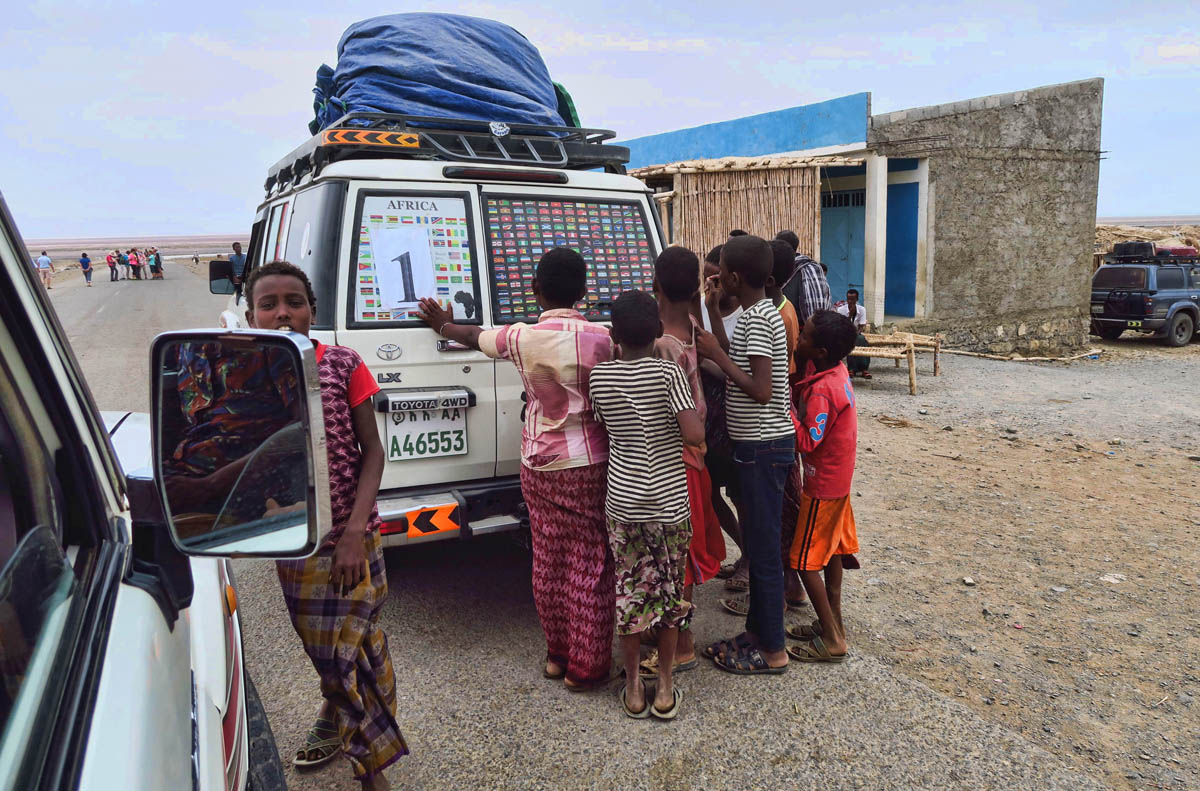
One of the Toyotas in our caravan had a grid of world flags in the back window. It was fun watching these young boys look for flags they recognized.
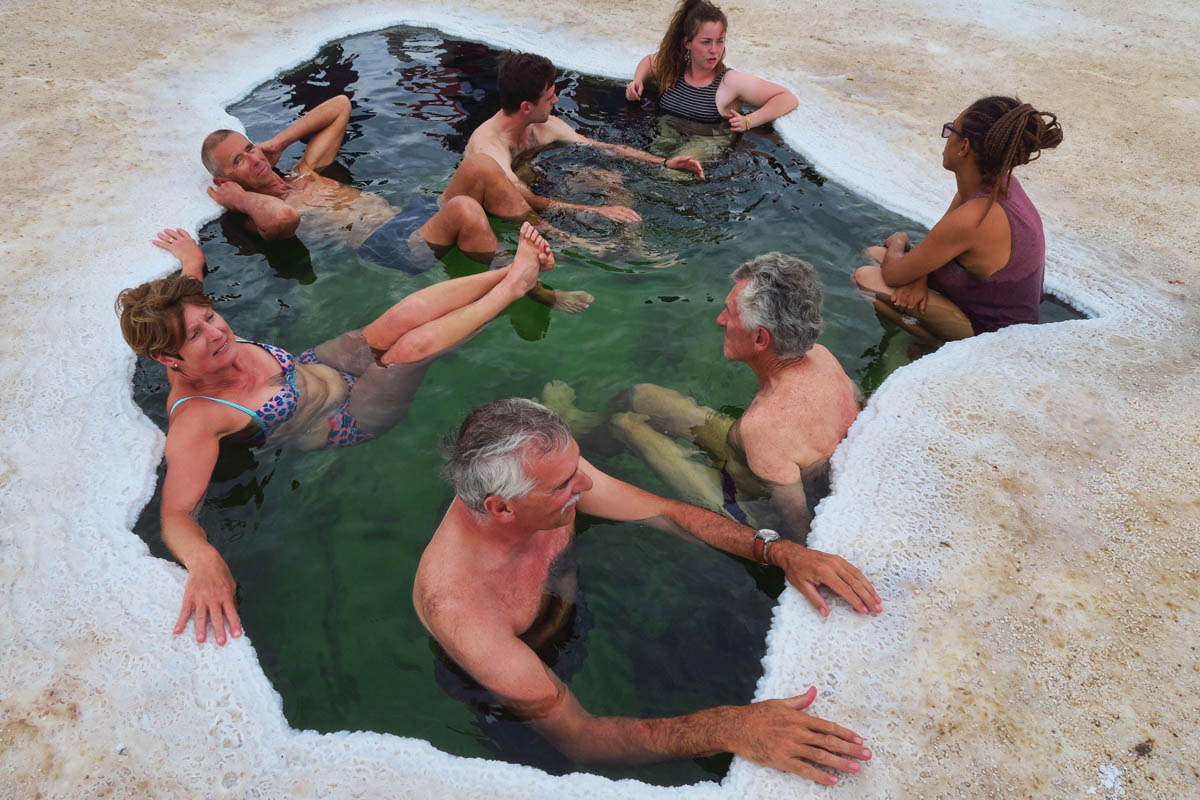
This warm salt pool occurs naturally in the middle of nowhere. It is as salty as the Dead Sea, making it impossible to sink. I didn’t bring my swimsuit because I didn’t want to carry it around wet, but sorta wished I had.
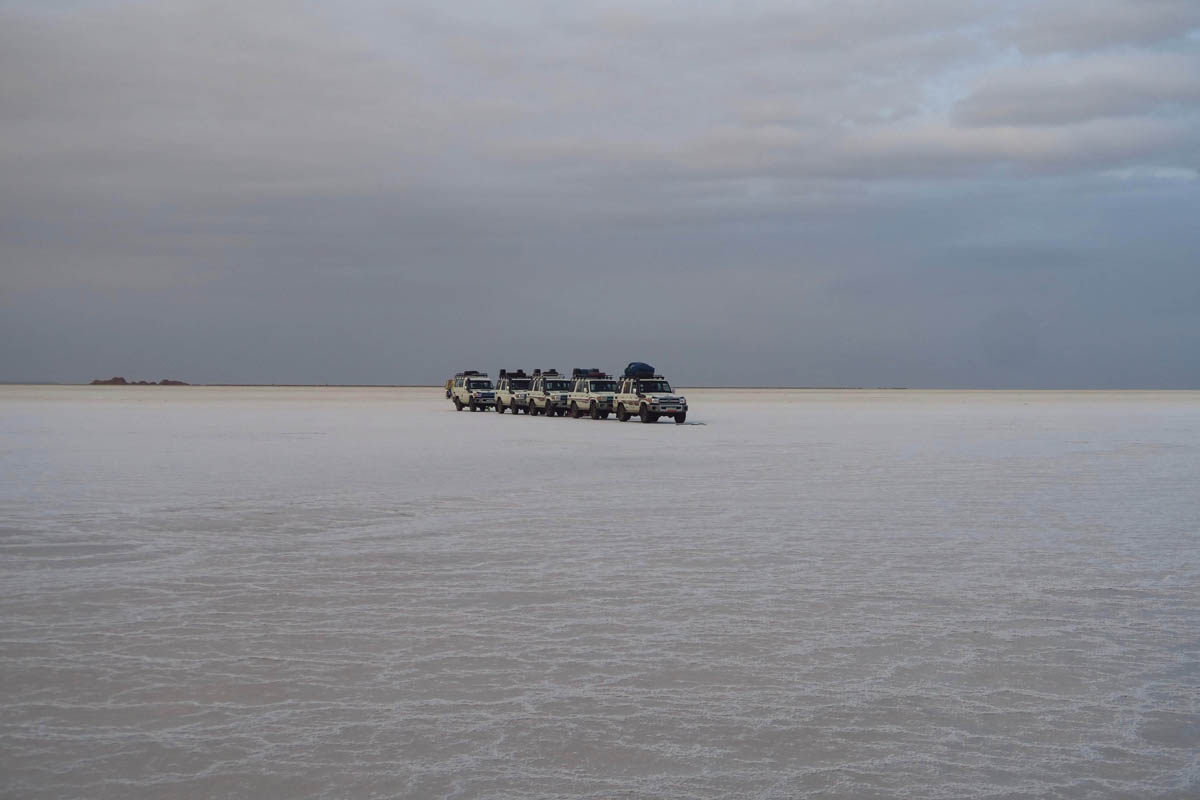
Our caravan drove to the salt lake for sunset.

Lake Asale where the transition from the salt pan to salt lake is so gradual that it’s tough to define the “waters edge.

The reflections in the shallow lake were eerily beautiful.
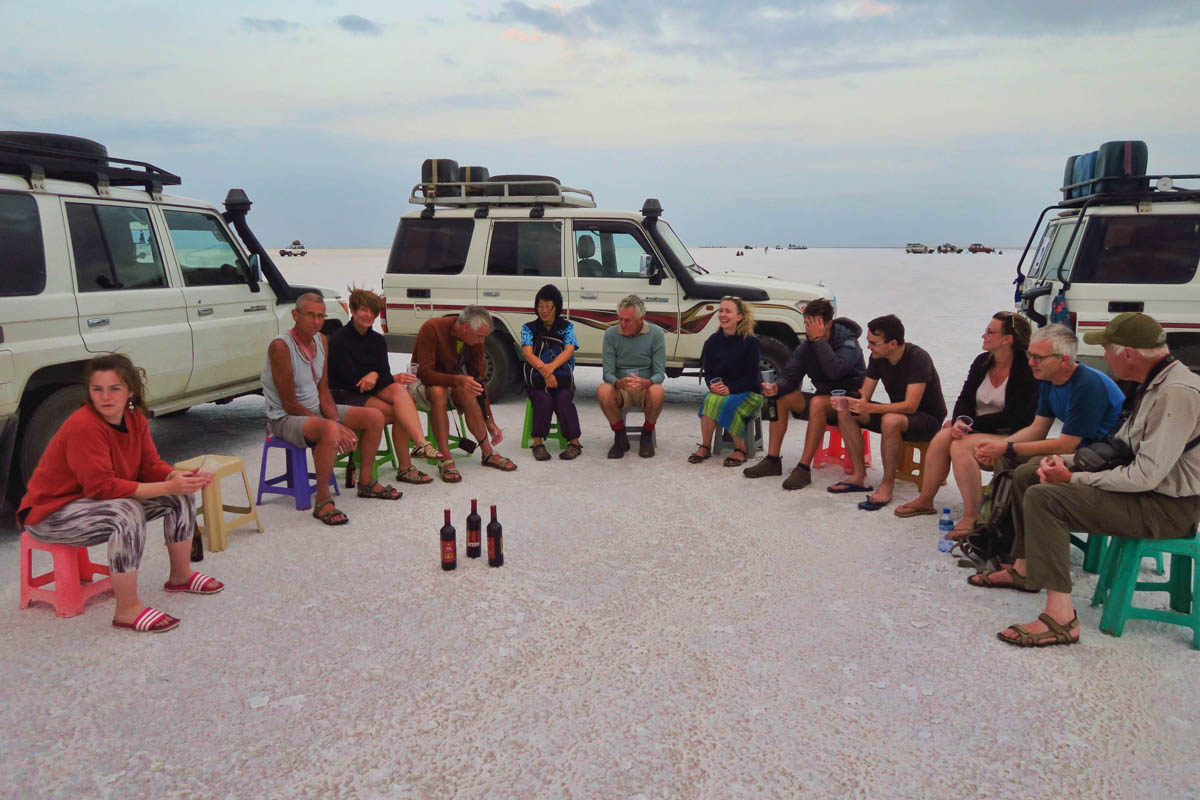
All circled up drinking bad Ethiopian wine, waiting for the sunset that never happened.

This is as good as the sunset got, though beautiful enough in its own right.
We were well prepped for the journey with warnings to bring lightweight clothing and only a sleeping bag liner to put on the cots. The vehicles were loaded with food and plenty of water, along with jerry cans for washing. Prior to leaving we got a briefing from Louise on how important it was to stick together, not wander away from camp, and to drink, drink, drink plenty of water to avoid dehydration from the scorching heat. Our touring would start at 5:00am to avoid the hellish heat for which Dallol (volcanic cinder cone crater, the center of the Danakil, location of sulfur pits and hot springs) was infamous.
“However…” (seems there’s often a “however” on this trip) the morning we left Mekele was overcast and uncharacteristically cool. In fact, I left on the trip wearing a long-sleeved tee shirt over a short-sleeved tee shirt for extra warmth. I never took it off for the entire trip, and in fact, even the puffy jacket came out after dark. Our time in the “hottest place on earth” would turn out to be downright cool!
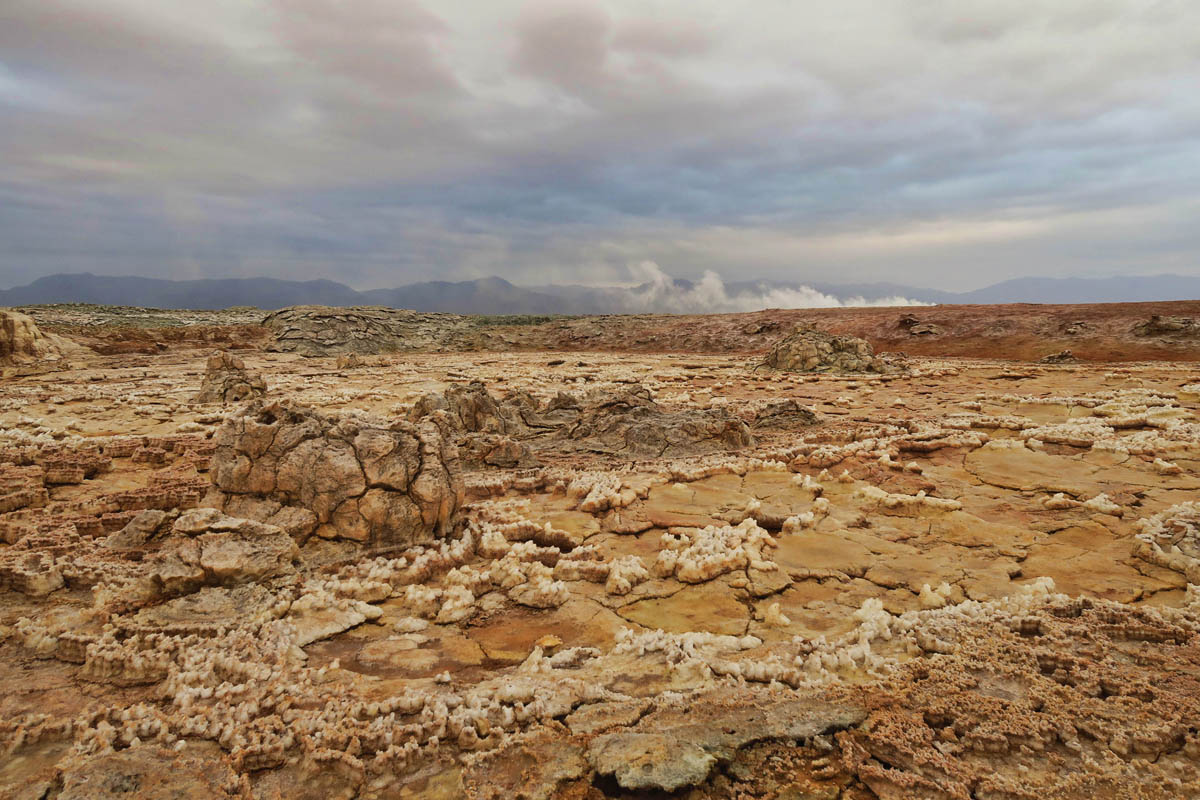
Once we arrived at Dallol, we had about a 20 minute hike across this terrain to reach the hydro-thermal area.

No two surfaces along this walk looked the same.

Steam billowing up is from sulfur pits. The smell of rotten eggs was present, but not putrid.
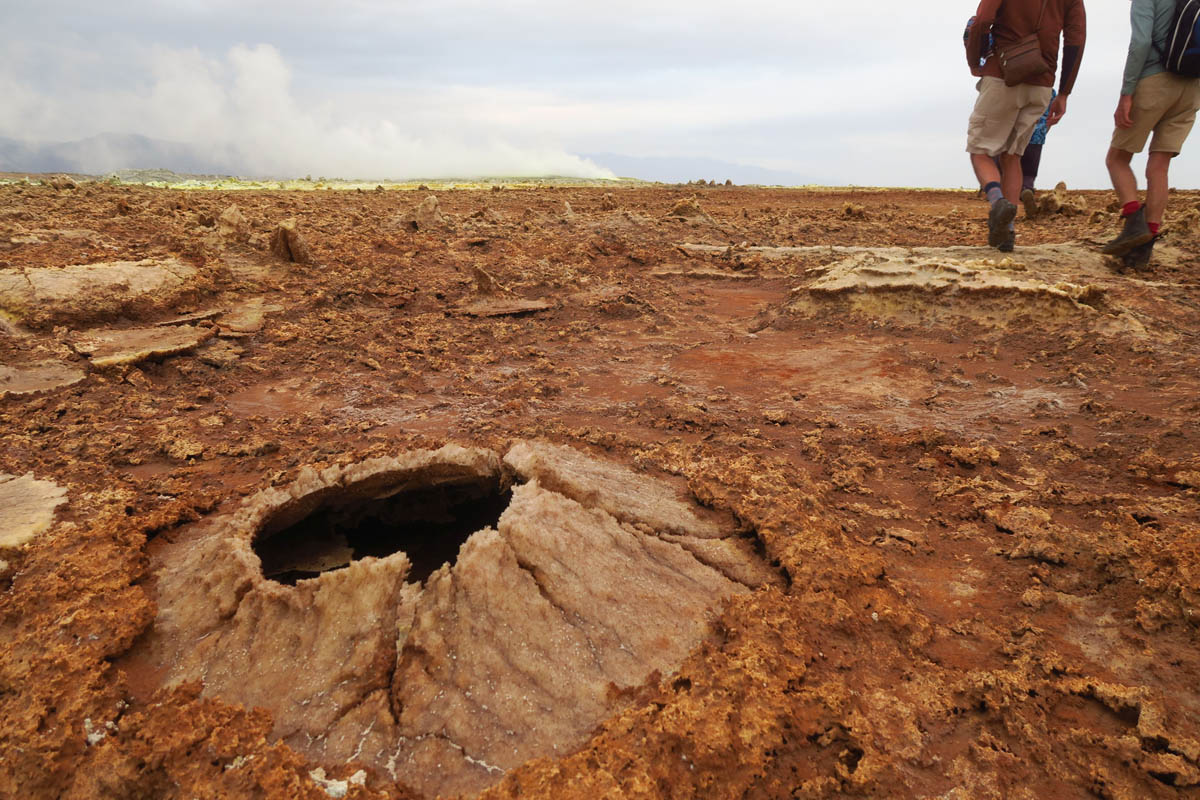
Better watch our step! There is no real designated path. I just kept thinking over and over, “I can’t believe we are walking on this!”

Salt had bubbled to the surface in many areas making these delicate crystal mounds. We could hear bubbling and hissing inside some of them.
After setting up camp we headed off toward Lake Asale, salt flats that were once a part of the Red Sea. The salt is up to one kilometer (3,280 ft) thick beneath this shallow lake. The plan was to return to this lake the following morning to watch the sun rise, unfortunately the cloud cover did not clear throughout the night. I know, because I was awake for half of it. There is a fierce gale wind that blows across the Danakil known as “Gara,” or “fire wind.” It feels both hot and cold at the same time, and is relentless in it’s velocity. I was awake half the night worrying that I would roll over and my only inflatable pillow would fly away, ending up in Eritrea.
Even though there was no sunrise, we still kept to the same schedule of waking up at 5:00am, typically to avoid the heat. But we kept to the schedule in spite of being “unseasonably cool” during our visit.
Our first stop would be Dallol, which is a volcanic cinder cone believed to have formed in 1926 when emergent magma came in contact with the standing salt water lake. What resulted was geysers, conical vents, crystalline formations, sulfurous pools, and potash deposits. Including the 20 minute hike to and from the hydro-thermal area, we would spend about two hours just wandering in and around this bizarre multi-colored psychedelic mind-bending “trip” of a hike.
But that wasn’t all, as just next door was an area they called “Black Mountain” which looked like canyons, pinnacles and spires all made from salt. And finally, a bubbling oil lake rimmed in apricot colored crystal formations. All the while, the Grateful Dead song kept running through my head, “What a long, strange trip it’s been!” If only “Lucy in the Sky” had been more cooperative.
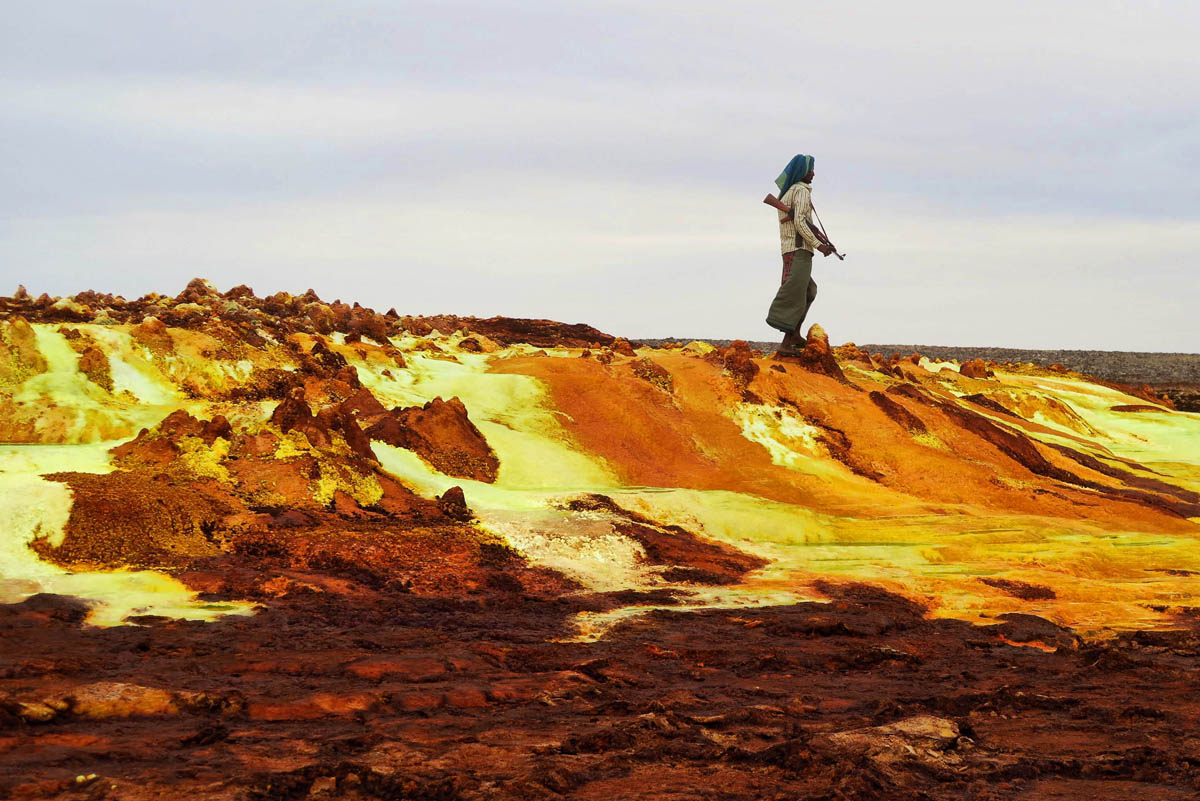
We had scouts again this time. Whereas they were really more for “local employment” in the Simiens, here they are actually serving a purpose. We are only 15 miles from the Eritrea border where unrest has been a problem in years past.
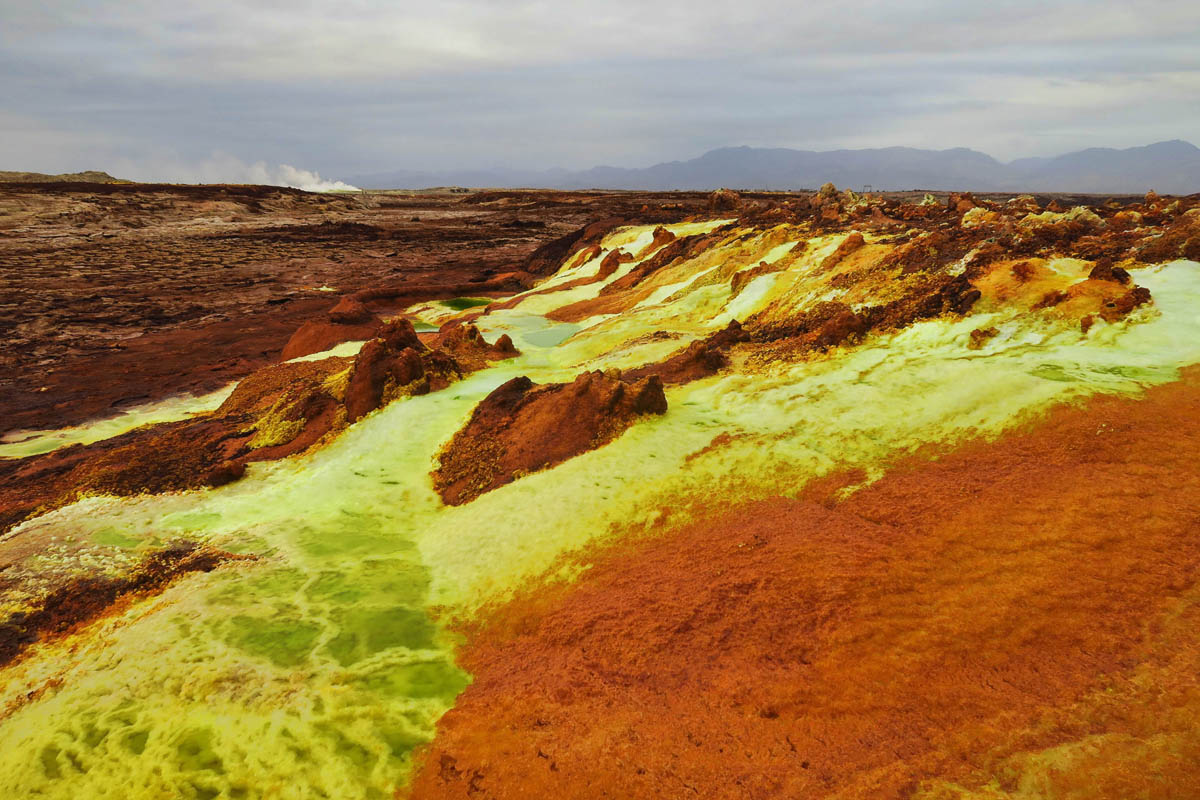
The guides keep telling us we would not be able to spend as much time here seeing all the different areas if it were not for the coolness brought about by the otherwise disappointing cloud cover.

Sarah helps add some scale as to the size of the hot pools.
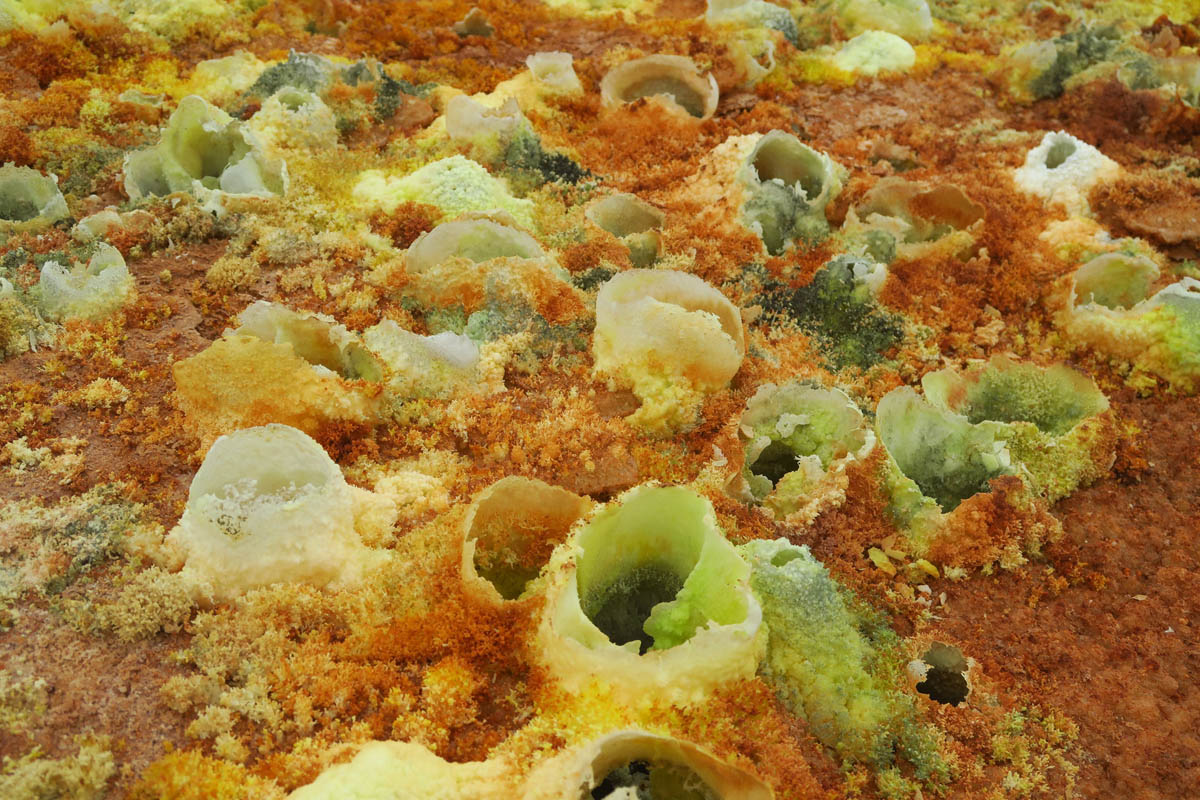
These are all made up of delicate salt crystals.
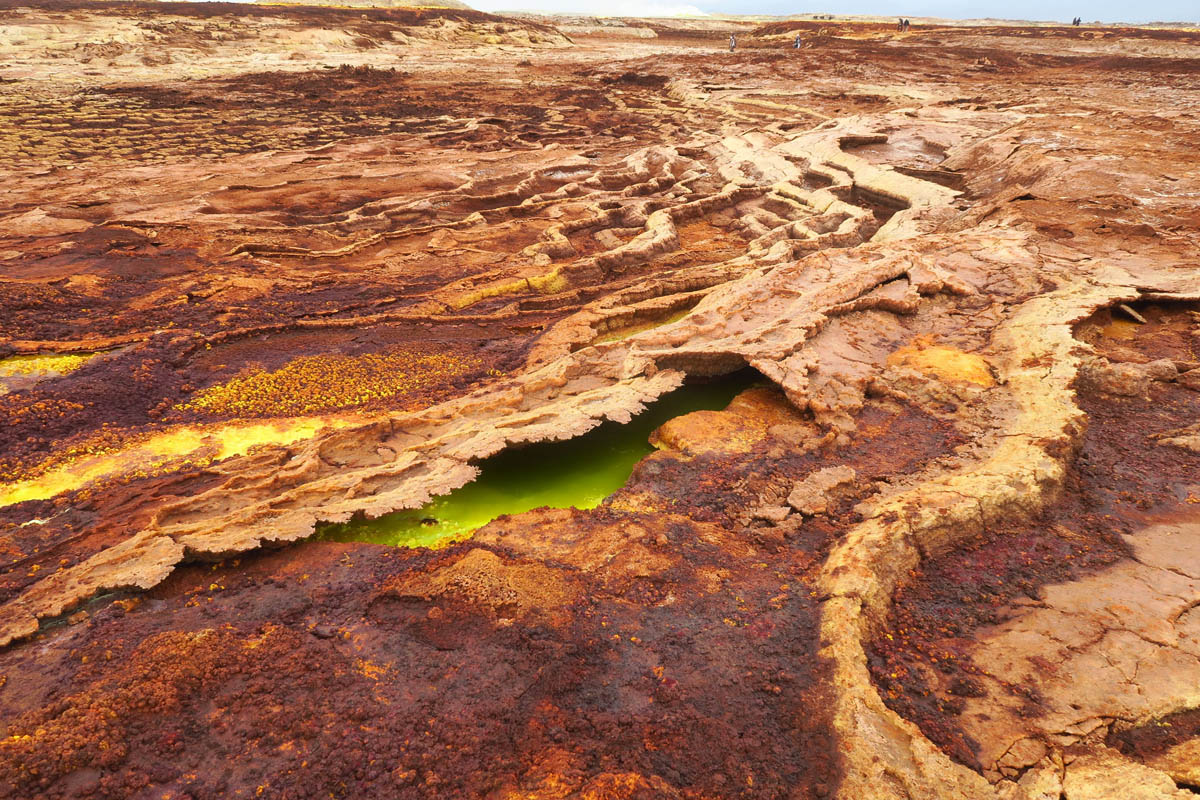
Again I say I can’t believe we are just hiking across this place…

The Danakil Depression is in the Afar Region. The Afar people are very different from most Ethiopians in stature, culture, and religion as they are primarily Muslim. They wear this “toga” which is a continuous loop of fabric folded over like a long skirt.

Can you imagine what these colors must look like in the full brilliant morning sun instead of our overcast day?
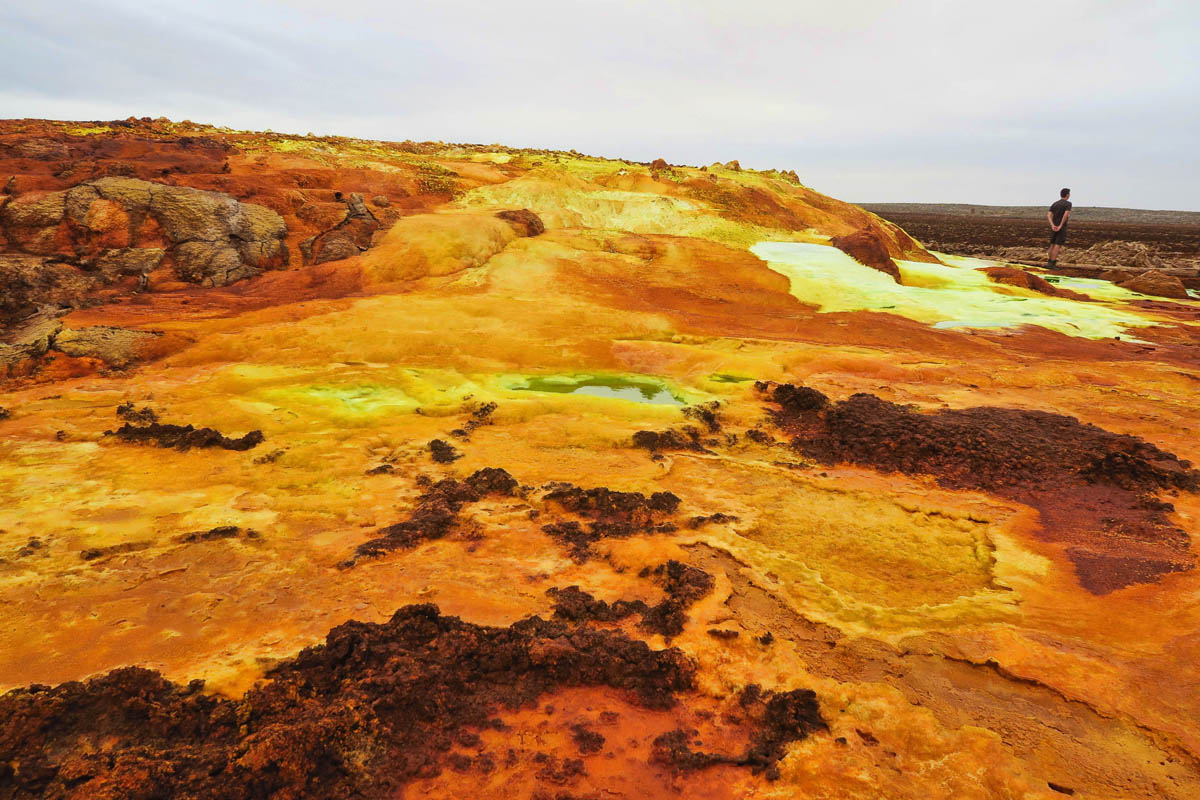
Sometimes it makes me think of lasagna hot out of the oven. That’s Jasper in the distance, once again providing scale to the place.

After walking a bit further, we come to the place where the formations are taller. These are about shoulder height.

That little tuft on the upper left of the white area is like a little geyser, spitting out steaming hot water.

As per wikipedia, “pH, salinity, high temperature, lack of oxygen, etc. render Dallol one of the very few ‘poly-extreme’ sites on Earth.”

More from Wikipedia, “Unlike Yellowstone where the colors are generated by biological activity, the color palette of Dallol is produced by the inorganic oxidation of the abundant iron phases.”
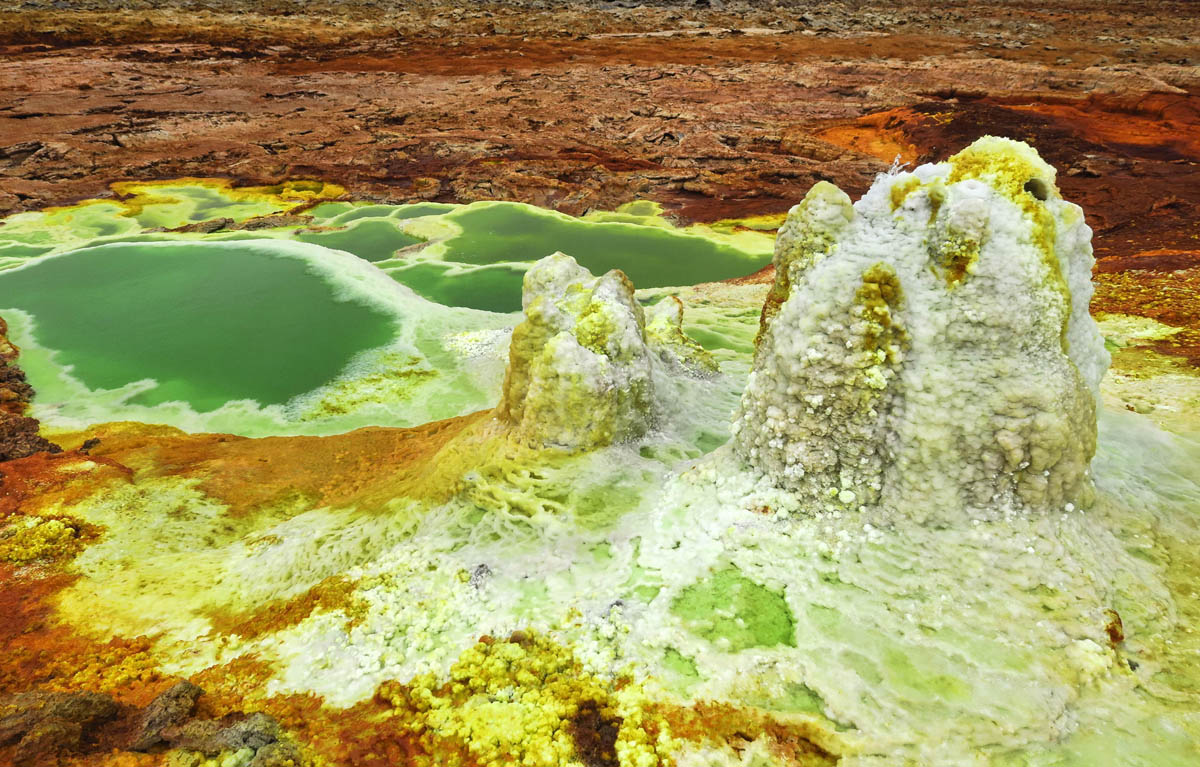
Wikipedia’s prose is more eloquent than mine, “Another fascinating feature of Dallol is the wide array of unusual mineral patterns such as salt-pillars, miniature geysers, water-lilies, flower-like crystals, egg-shaped crusts and pearl-like spheres.”

Hiking out, we encounter some formations that look like some kind of plant stalks I am at a loss to describe.

This is known as the Black Mountain area, though the mountains are made of salt.
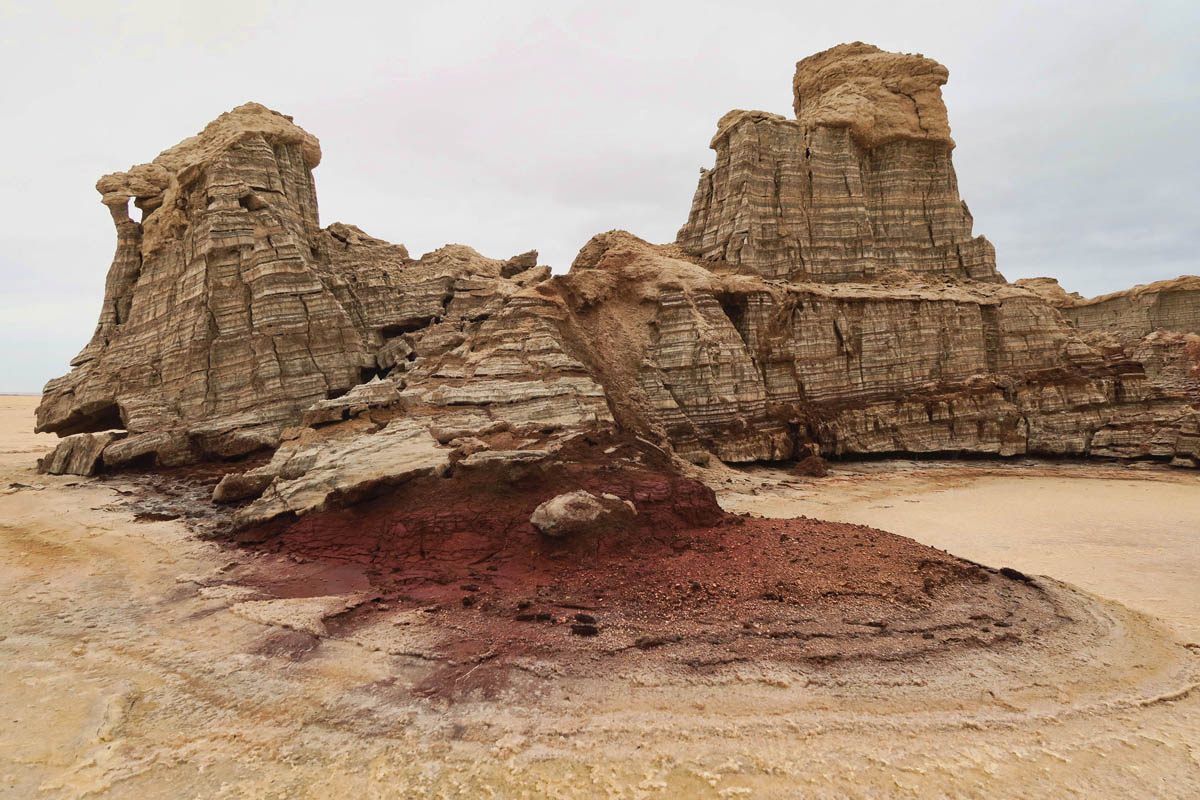
Prior to getting back in the vehicles, there will be “mandatory boot cleaning” after walking on this.

Leaving the Dallol crater, we make a stop at “Oil Lake.” Though cold, this viscous mineral fluid is “boiling.”
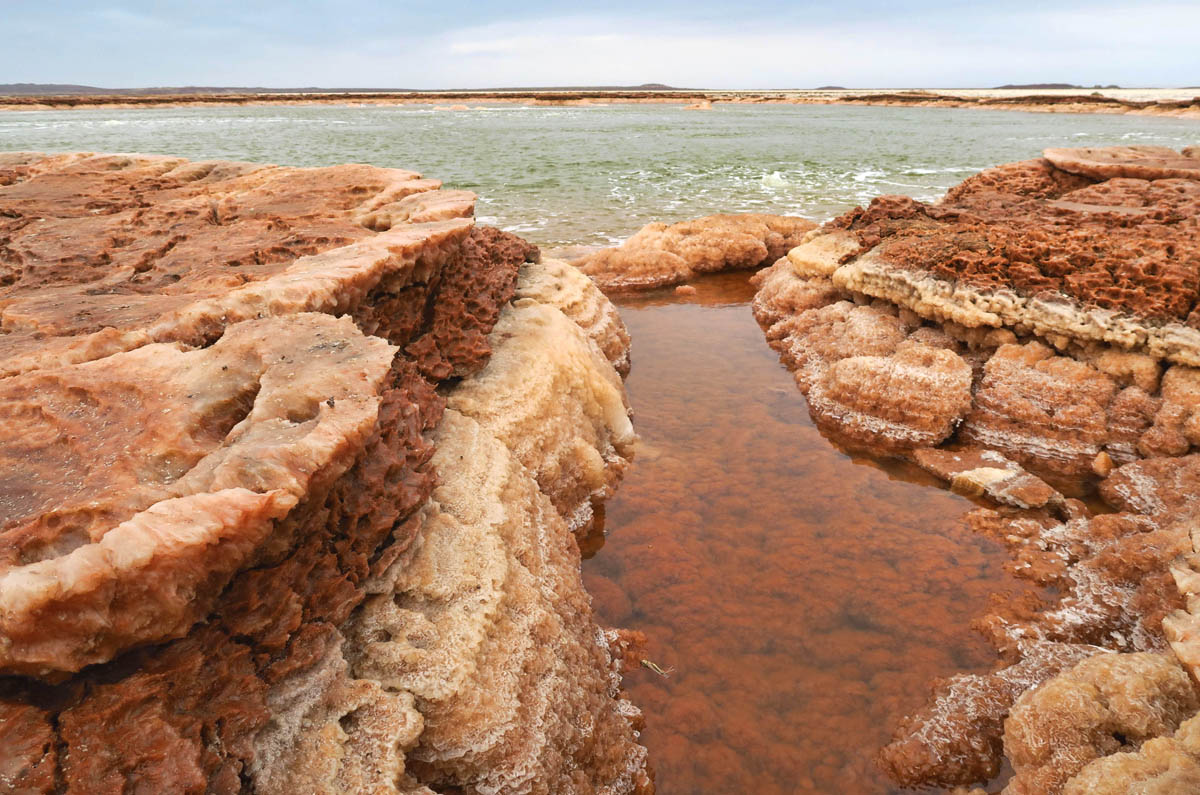
The oil feels like a very light mineral oil, and guide tells us it’s “good for the skin.”
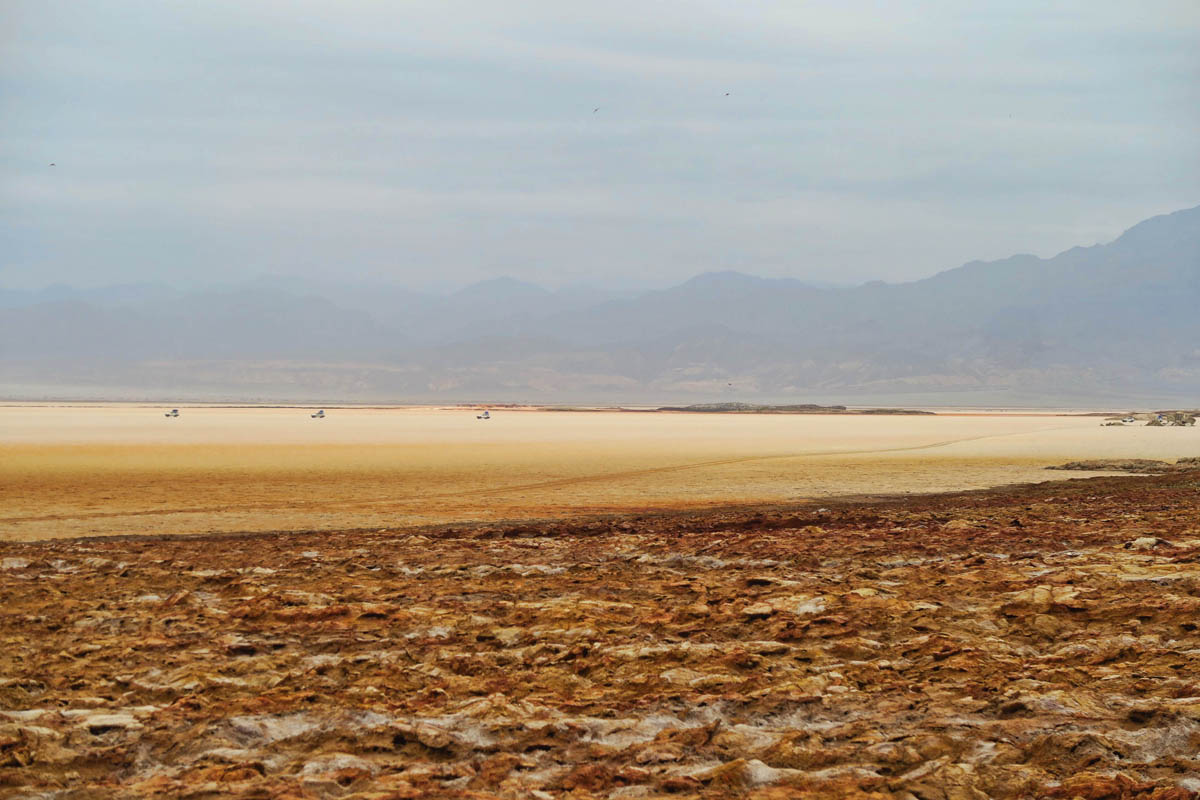
From the edge of the Dallol, looking out over the salt desert, three Land Cruisers race across the salt flats in the far distance.
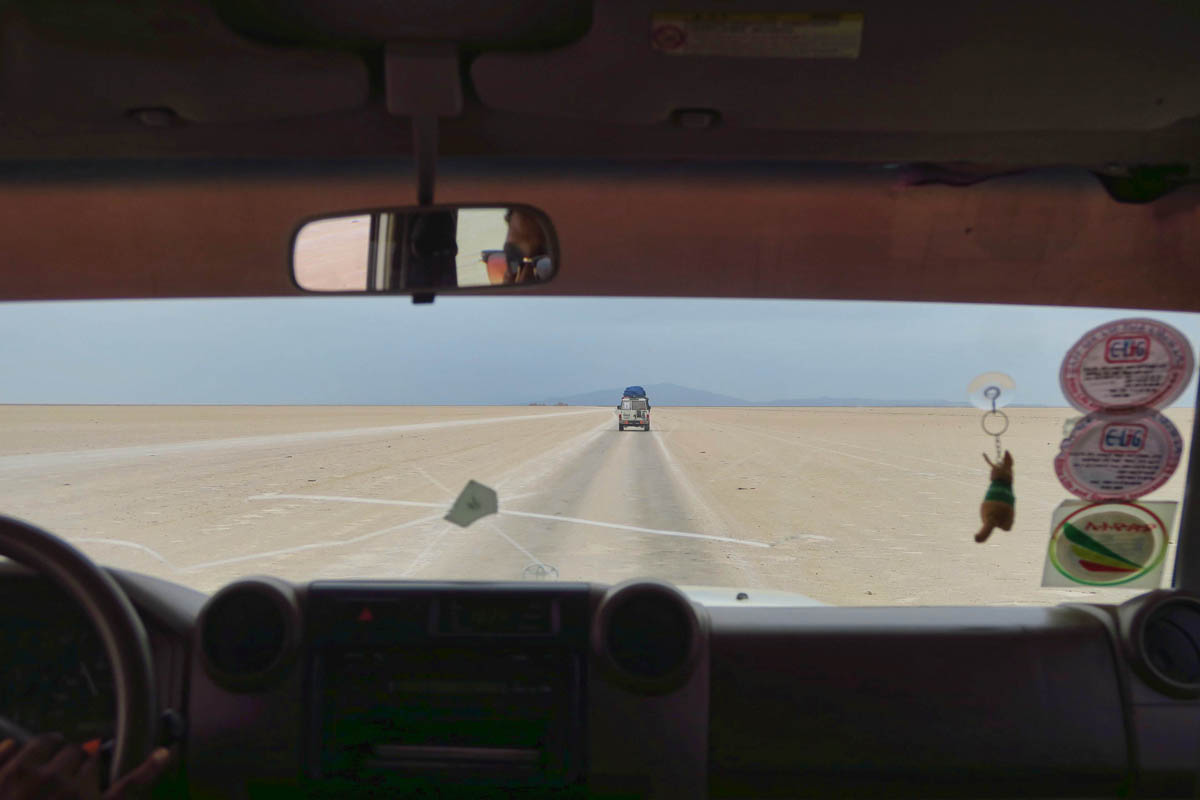
Here’s how that looks from inside the vehicle, as I watch the speedometer hit 80kms. Feels like we are taxiing down the runway, though it’s really only 50 mph.
I loved journeying into this most fascinating of places, I definitely felt the “depression” of Danakil. I never could quite put a finger on it. I just didn’t feel myself. I was lethargic, a bit nauseous, and felt a bit withdrawn. Part of this might have been from the gaseous fumes and the smell of rotten eggs wafting through the air. Part was from the gale force winds that never relented the entire time, where all gear had to be anchored down or lost forever.
I also attributed part of it to being depressed over the oppressive cloud cover. While our guides tried to assure us how lucky we were, as our time would have otherwise been severely limited by the usual heat, I couldn’t help but obsess over how much better my photos would have been in the golden sunlight of early morning. We went with plans to watch both the sunset and sunrise over the salt lake, neither of which happened as we all stared across the horizon hoping for a break in the clouds. I came all this way, and will not pass this way again, so it was tough not to feel down about the weather.
But there was more. While I would not trade this fascinating experience for anything, it just felt like a depressing place. In the next post, I will write more about why I felt the “depression” of the Danakil, a place National Geographic deemed to be “The cruelest place on Earth.”

What a fascinating place! Makes Yellowstone’s pools and formations seem totally insignificant! I find that overcast days can yield the most vivid colors, especially if you are not using a polarizing filter. As far as the “depression” just play this song in your head, I’m sure you know it well….. The Road is long with many a winding turn
I am both in awe and confused. The caldron of life is a strange, forbidding, hot, ugly and spectacular place. I am happy that you visited and shared with us, but I am confused by the armed humans defending the area. I am going to have to research this area further, thank you once again for visiting and documenting that visit.
Hi, Allen,
We were only 15 miles from the border with Eritrea. There has been a conflict/war over the border for 20 years, and the 20 year war only ended in 2018. If you google, you will find a German tourist and his (unarmed) guide were shot coming down from the volcano, Erta Ale. While this was an isolated incident, the armed guard is to insure it doesn’t happen again. Thanks! Give my best to Deede.
Absolutely fantastic! I had no idea such a place exists. Once again you introduce us to unique places. Don’t worry about missing the “Golden Hour” photographs. The colors brought out by the diffused and muted light are striking. You captured the area in a way most travelers would not have seen had they been there under typically clear skies.
Scott I agree with you, I thoroughly enjoyed this post and photos which I thought were fantastic. Thank you Suzanne for sharing!
I cannot imagine these photos had the sun been out! Stunning. Anxious for your next post.
Thank you for a wonderful look at a place I will never see. While I completely understand about missing the sun, the photographer I live with always says cloudy days make for better color and WOW the colors you saw!! I am also amazed you hiked all over that place. I think I would be very apprehensive of stepping/falling through…and of course if it was here in the states, you wouldn’t be allowed to in the first place.
Fascinating place! Just imagine what this would look like if located in the US with boardwalks everywhere and signs warning to not walk off trail. I guess they don’t get enough visitors to damage the area?
Gayle, I asked about this, and was told it is such a rapidly changing environment that the number of tourists today don’t leave an impact. They said in three weeks time, the surface crust will have changed again. Kinda scary, considering we were walking on it!
Your photos of the vast body of lake and those beautiful crusty, crystal mounds of varying hues reminds me of a sea of pearl…and this quote:
“The liquid drops of tears that you have shed
Shall come again, transform’d to orient pearl,
Advantaging their loan with interest
Of ten times double gain of happiness.”
~ William Shakespeare, Richard III
Groovy, man! Psychedelic for sure. What a wild, strange trip of a place! Some of those salt mounds seem to have faces (the stuff nightmares are made from). 🙂
And the geysers remind me of Iceland (ya know, there is a UNESCO site there – just sayin’) 😉
Looking forward to the next post!
Wow!! What a spectacular stop. The colors and features are so awesome. Thanks for including so many photos so we can try to appreciate what you were lucky enough to see first hand.
What an amazing experience. And I thought Yellowstone was incredible…